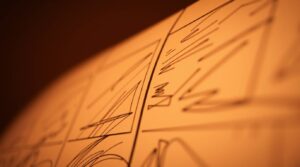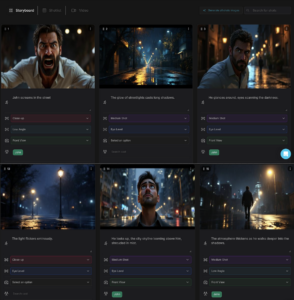How to Master Storyboarding for Animation Movies Using an Animation AI Storyboard Generator
Discover how to streamline your animated filmmaking process with an Animation AI storyboard generator. Learn the benefits, tools, and best practices for modern storyboarding.
In animation, the story begins long before the first frame is rendered. It starts with vision, planning, and—most importantly—structure. That’s why storyboarding sits at the core of every animated production, whether you’re crafting a 2-minute YouTube short or directing a feature-length film. In an art form where everything is created from scratch, the storyboard serves as your map. It defines how action flows, where emotions land, and how the viewer experiences your story from start to finish.
Traditionally, animated storyboards, or animatics, have been labor-intensive, requiring skilled artists, revision loops, and time-consuming hand-drawn sequences. But today, the rise of AI-powered tools is changing that process in a profound way. Using an Animation AI storyboard generator, animators can now visualize scenes faster, explore alternatives more freely, and produce consistent, high-quality storyboards—even without advanced drawing skills or large teams.

Visit shaicreative.ai and start building your world today.
Why Storyboarding is So Crucial in Animated Films
Animation is built on intention. Every gesture, background detail, and camera move must be carefully planned. Unlike live-action filmmaking—where you can experiment on set—animation demands precision before production begins. That’s where the storyboard comes in. It provides a visual outline of each scene, capturing timing, movement, and tone long before a single frame is animated.
A solid storyboard helps define character positions, establish the rhythm of dialogue, and fine-tune the pacing of visual gags or dramatic moments. It prevents wasted effort by helping directors identify what works—and what doesn’t—before animation begins. This is particularly valuable in projects where resources are tight and revisions are costly.
With modern AI tools, this process can be accelerated significantly. By feeding your script or scene descriptions into an AI-powered platform like Shai, you can receive fully visualized panels in minutes. The technology interprets tone, character, and action to produce frame sequences that look and feel cohesive—without requiring hours of manual work.
Traditional Storyboarding vs. AI-Powered Tools
In the past, animated storyboarding was a craft reserved for trained artists. Panels were drawn by hand, often revised repeatedly, and had to maintain consistent style and proportion throughout. It was effective but slow—especially for creators working solo or under tight deadlines.
Today, an Animation AI storyboard generator transforms that workflow. Instead of sketching each frame, you describe your scene in words. The AI translates your ideas into illustrated sequences, applying visual coherence and style control automatically. You can select moods, character styles, or even specific camera directions, and the AI renders a draft that’s ready for feedback and editing.
Platforms like Shai elevate this further by maintaining AI character consistency—ensuring that your characters remain visually recognizable across multiple scenes. You can even use Shai’s AI character generator to craft protagonists, background extras, or fantasy creatures unique to your project, all while staying true to the chosen animation style.
This process doesn’t just reduce the time spent sketching—it encourages experimentation. You can try out a scene in three different visual tones or camera setups, and pick the one that feels most aligned with your story—all within a single working session.

How an Animation AI Storyboard Generator Works
The mechanics behind an AI storyboard tool are simple, but powerful. You input your script or a scene description—ideally with as much detail as possible. Then, the AI breaks it down into story beats and translates each into a storyboard frame. You can specify the visual tone (cartoon, anime, minimal sketch, etc.), the color palette, or even lighting themes. From there, you’re free to review, rearrange, edit, or regenerate any panel.
With Shai, this process is particularly intuitive. You can drop in a complete script and have the AI map out a scene-by-scene breakdown. Each panel will include camera angles, character emotions, background details, and even optional dialogue placement. If something doesn’t feel right—perhaps the expression is too flat or the angle too static—you can regenerate with a single click. No redrawing. No starting over.
Once your storyboard is locked, you can export it in a variety of formats: PDF for presentations, PNGs for integration into animation software, or even video files for building rough animatics. The workflow blends well with industry-standard tools like Adobe After Effects or Toon Boom Harmony.
Visit shaicreative.ai and start building your world today.
Why AI Storyboarding Is Transforming Animated Filmmaking
What makes this shift so compelling isn’t just convenience—it’s creative freedom. Independent animators, students, and small studios are now able to pre-visualize complex scenes without the limitations of hand-drawn boards or rigid templates. By letting AI handle the heavy lifting, creators are free to focus on narrative decisions, visual rhythm, and emotional tone.
Need to storyboard an alternate ending? Want to experiment with three different camera angles for a chase scene? Looking to test pacing for a comedic beat? AI lets you iterate rapidly, giving you more room to discover the best version of your story.
For example, one short film project, “Light Years Apart,” used an AI storyboard generator to explore its space scenes and alien environments. What would have taken weeks was completed in days—allowing the creative team to focus their efforts on final character animation and sound design. Another series, “Byte-Sized Adventures,” built weekly episodes using AI to storyboard dialogue-driven moments, keeping characters and style consistent across episodes, despite a tight release schedule.
Integrating AI Storyboards into the Animation Pipeline
An AI storyboard generator isn’t meant to replace traditional tools—it complements them. Once you’ve generated a visual sequence, you can use it as a base for further refinement, or hand it off to your animation team for feedback. Many tools allow collaborative editing, annotations, and shared workspaces—perfect for remote teams or fast-paced productions.
Shai, for instance, enables real-time commenting and version tracking, which helps directors, animators, and producers stay aligned through pre-production. You can export the visual sequence as frame-by-frame references or drop them into software like After Effects to start animatic builds.
This tight integration helps reduce bottlenecks, streamline feedback loops, and maintain creative momentum throughout your production timeline.
Common Pitfalls and How to Avoid Them
Of course, AI isn’t magic—it’s a tool. To get the best results, your inputs still matter. Vague scene descriptions can lead to generic outputs, so it’s worth spending time crafting detailed prompts. Include context, emotion, actions, and tone. Treat the AI like a visual interpreter—clear directions yield better visuals.
It’s also important not to over-automate. AI panels can look polished, but that doesn’t mean they’re the right fit creatively. You’ll still want to review, adjust, and make judgment calls—especially when dealing with comedic timing or emotionally complex scenes.
Lastly, remember that not all AI storyboard tools are created equal. Look for platforms like Shai that offer customization, character consistency, and genre versatility.
The Future of Storyboarding in Animation
As AI continues to evolve, we’re entering a new era where the storyboard itself becomes more dynamic. Instead of static frames, we’ll see AI-generated animatics, complete with motion paths, dialogue timing, and scene transitions. Some tools are already exploring real-time scene simulation—allowing creators to test blocking and layout before final animation begins.
We’ll also see greater personalization. Imagine training an AI engine on your unique artistic style—so that every storyboard generated feels like it came from your own hand. Whether you’re directing a gothic fairytale or a hyper-minimalist comedy, the storyboard will reflect your visual identity.
These changes don’t replace the role of directors or animators—they augment them. And for those who embrace it, the Animation AI storyboard generator will become not just a production tool, but a creative partner.
Visit shaicreative.ai and start building your world today.